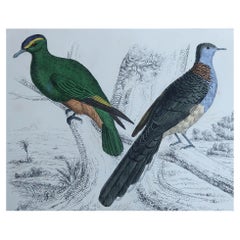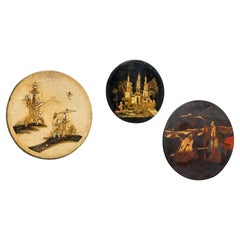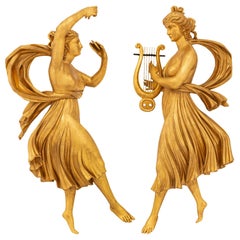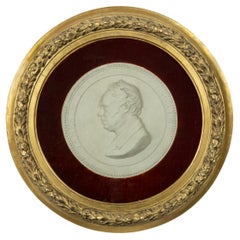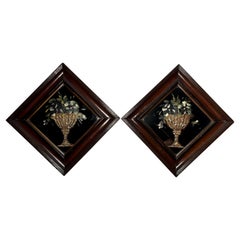19th Century Decorative Art
535
6,495
to
944
4,802
1,608
6,495
6,495
6,495
331
197
97
89
68
52
25
22
18
17
17
10
8
7
4
4
2
1,899
6,495
7,373
2,680
1,638
2,372
1,628
347
82
287
212
183
501
551
605
284
163
Height
to
Width
to
4,464
865
721
411
300
2,346
833
809
704
210
51
46
44
43
41
Period: 19th Century
Original Antique Print of Pigeons, 1847 'Unframed'
Located in St Annes, Lancashire
Great image of pigeons.
Unframed. It gives you the option of perhaps making a set up using your own choice of frames.
Lithograph after Cpt. brown with original hand color.
Publish...
Category
English Folk Art Antique 19th Century Decorative Art
Materials
Paper
Set of 3 Decorative Round Chinoiserie Wall Hangings
Located in Wormelow, Herefordshire
A trio of decorative antique Chinoiserie wall hangings dating from the late 19th century. Varying in size, these three artistically decorated roundels are a stylish addition to inter...
Category
Antique 19th Century Decorative Art
Materials
Wood
Pair Of Continental 19th Century Louis XVI St. Giltwood Wall Decor
Located in West Palm Beach, FL
A very decorative pair of Continental 19th century Louis XVI st. Giltwood wall decor. Each of the richly carved maidens is wearing classical attire, with their hair in an updo and ho...
Category
Unknown Louis XVI Antique 19th Century Decorative Art
Materials
Giltwood
A framed plaster portrait plaque of the Glasgow Reformist MP James Oswald, signe
Located in Lymington, Hampshire
A framed plaster portrait plaque of the Glasgow Reformist MP James Oswald, signed and dated Carlo Marochetti, 1842, of circular form, shown facing to the right within a black border and the original glazed giltwood frame.
Another version of this plaque is in the collection of Glasgow Museums and can be seen on the Art UK website
James Oswald (1779-1853) was a successful Glasgow merchant who later inherited various landed estates due to the early death of his cousin. Oswald was one of the first members of the Glasgow Bank when it was established in 1809. He traded largely in cotton and other raw textiles and in his spare time he commanded the Glasgow branch of the volunteer mounted Yeomanry. It was his political career however that captured the hearts of many of his countrymen and led to his eventually being immortalised in sculptural form.
The Liberal Party MP for Glasgow from 1832-1837, Oswald was a staunch opponent of Sir Robert Peel...
Category
Antique 19th Century Decorative Art
Materials
Plaster
Antique French Hand-Painted Majolica Porcelain "Beagles" Wall Pocket, Circa 1890
Located in New Orleans, LA
Antique French hand-painted Majolica porcelain "Beagles" wall pocket, Circa 1890's.
Category
French Antique 19th Century Decorative Art
Materials
Majolica
Pair 19th Century Antique Victorian Plaques
Located in New Orleans, LA
Pair 19th Century Antique Victorian Plaques
Category
English Antique 19th Century Decorative Art
Materials
Glass
Romeo and Juliet, a pair of antique Italian Carved Marble Sculptures
Located in Los Angeles, CA
This magnificent pair of antique Italian life-sized hand-carved marble figures depicts Romeo and Juliet, the young lovers in the famous play by William Shakespeare.
One figure show...
Category
Italian Antique 19th Century Decorative Art
Materials
Marble
Antique Swiss Walnut Nature Mort
Located in New Orleans, LA
Antique Swiss walnut nature mort.
Category
Swiss Antique 19th Century Decorative Art
Materials
Walnut
Queen Victoria Authentic Strand of Hair with Certificate of Authenticity
Located in Jersey, GB
Few British rulers have cast as long a shadow as Queen Victoria. Her reign lasted 63 years, which stood as the record up until great-granddaughter Elizabeth II surpassed her in 2015....
Category
Antique 19th Century Decorative Art
Materials
Other
Decorative Vienna Porcelain Tray
Located in New Orleans, LA
A wonderful large Vienna porcelain tray with a beautifully painted genre scene entitled "Die Ainkunftam Tanzboden" after Austrian genre painter Franz von Defregger...
Category
European Other Antique 19th Century Decorative Art
Materials
Giltwood
Italian 19th Century Big Size Florence Architectural Hand-Coloured Print
Located in Scandicci, Florence
A rare extra-large print, printed on engraving paper with an antique star press and watercoloured by hand representing an antique capital. The capital'...
Category
Italian Neoclassical Antique 19th Century Decorative Art
Materials
Paper
Antique French Oak Gothic Revival Panel
Located in Denton, TX
French oak hand carved Gothic revival panel. There are three available. Each panel is 1" deep by 8.5" wide by 13" high.
Category
French Gothic Revival Antique 19th Century Decorative Art
Materials
Oak
Original Antique Print of Japanese Cloisonne Enamels, Dated 1876
Located in St Annes, Lancashire
Great image of cloisonne enamels
Chromo-lithograph after A. Willms
Published by Sutton Sharpe & Co. 1876
Unframed. It gives you the option of perhaps making a set up using y...
Category
English Japonisme Antique 19th Century Decorative Art
Materials
Paper
French Chateau Landscape Oil Painting in Original Gilt Frame
Located in Stamford, CT
A Napoleon III era oil on canvas painting of a chateau and landscape in a gilt frame. A lovely composition in very good condition.
Category
French Napoleon III Antique 19th Century Decorative Art
Materials
Canvas, Wood
Original Antique Print of a Chinese and Japanese Plate, France, circa 1860
Located in St Annes, Lancashire
Wonderful print of a Chinese and Japanese plate
Lithograph
Published by A.Morel, Paris, France, circa 1860
Unframed.
Category
English Chinoiserie Antique 19th Century Decorative Art
Materials
Paper
Original Antique Print of a Nightjar, circa 1880, 'Unframed'
Located in St Annes, Lancashire
Great image of a Nightjar
Unframed. It gives you the option of perhaps making a set up using your own choice of frames.
Lithograph after Alexander Francis Lydon.
Original color
P...
Category
English Folk Art Antique 19th Century Decorative Art
Materials
Paper
Antique Trout Fishing Prints, Set of Three Photogravures.
Located in Oxfordshire, GB
Three trout fishing pictures By Douglas Adams.
Set of three individually framed fishing scenes by Douglas Adams. The three photogravures are in new frames and titled Trout Fishing, ...
Category
British Sporting Art Antique 19th Century Decorative Art
Materials
Paper
Original Antique Print of a Giant Breve, 1847 'Unframed'
Located in St Annes, Lancashire
Great image of a giant breve.
Unframed. It gives you the option of perhaps making a set up using your own choice of frames.
Lithograph after Cpt. Brown with original hand color...
Category
English Folk Art Antique 19th Century Decorative Art
Materials
Paper
Original Antique Print of a Willow Warbler, circa 1880, 'Unframed'
Located in St Annes, Lancashire
Great image of a Willow Warbler
Unframed. It gives you the option of perhaps making a set up using your own choice of frames.
Lithograph after Alexander Francis Lydon.
Original ha...
Category
English Folk Art Antique 19th Century Decorative Art
Materials
Paper
French Majolica Oyster Plate Russian Imperial Eagle, circa 1890
Located in Austin, TX
French Majolica oyster plate called Russian imperial eagle, circa 1890.
Reference / page 132 "Oyster Plates" of Jeffrey B. Snyder.
Category
French Aesthetic Movement Antique 19th Century Decorative Art
Materials
Majolica, Ceramic, Faience
19th Century Majolica Fish Heads Oyster Plate Onnaing
By Onnaing
Located in Austin, TX
Rare 19th century Majolica fish heads oyster plate from North of France (Onnaing unsigned).
Reference: Page 130 "Collecting oysters plates" of ...
Category
French Victorian Antique 19th Century Decorative Art
Materials
Ceramic, Faience, Majolica
Original Antique Print of Dogs, 1847, 'Unframed'
Located in St Annes, Lancashire
Great image of dogs
Unframed. It gives you the option of perhaps making a set up using your own choice of frames.
Lithograph after Cpt. brown with original hand color.
Publi...
Category
English Folk Art Antique 19th Century Decorative Art
Materials
Paper
Burmantofts Faience Bacchanalian Green Glazed Tile
Located in Bishop's Stortford, Hertfordshire
A scarce Burmantofts Faience Bacchanalian tile of rectangular form modelled in relief with figures attending to a resting man set within a raised stepped edge and decorated in green ...
Category
English Antique 19th Century Decorative Art
Materials
Ceramic, Faience
Antique 19th Century Framed German Hand Painted Porcelain Plaque of a Gypsey
Located in Swedesboro, NJ
Frame Dimensions: Height: 10 1/2 in Width: 8 1/2 in Depth: 1 1/2 in
Plaque Dimensions: Height: 2 3/4 in Width: 2 1/4 in
This framed antique 19th century porcelain plaque of a gyps...
Category
German Rococo Antique 19th Century Decorative Art
Materials
Porcelain, Glass, Wood
19th Century Chinese Silk Tapestries in Bamboo Frames
Located in Oostrum-Venray, NL
A set of 19th-century Chinese silk tapestries, woven or embroidered entirely by hand.
Left and right represents a fishing village with women and men fishing at the net.
Both ba...
Category
Chinese Antique 19th Century Decorative Art
Materials
Silk, Bamboo
Set of 6 Antique Mycology Prints of the Common Stinkhorn and Other Mushrooms
Located in Langweer, NL
Set of six original antique mycology prints. It shows many mushrooms and other fungus. These prints originate from 'Cryptogamen-Flora, Enthaltung die Abbildung und Beschreibung Vorzü...
Category
Antique 19th Century Decorative Art
Materials
Paper
French, 19th Century Iron Shoemakers Shop Sign
Located in Buisson, FR
Original riveted sheet iron shoemakers shop sign. Unique find,
France, circa 1800-1850. Traces of red paint visible.
Weathered.
Category
French Folk Art Antique 19th Century Decorative Art
Materials
Iron
FOUR Individual Ceramic Delft Wall Tiles Hand Painted, 19th Century
Located in Lincoln, Lincolnshire
These are four attractive individual Delft ceramic wall tiles, dating to the second half of the 19th century.
All tiles are nominally 5 inches square and 5/16 to 3/8 inches thick....
Category
Dutch Dutch Colonial Antique 19th Century Decorative Art
Materials
Ceramic
Majolica Three Shells Oyster Wall Plate Longchamp, circa 1890
By Longchamp
Located in Austin, TX
Rare 19th Majolica three shells oyster wall plate signed longchamp.
Diameter / 8 inches.
Category
French French Provincial Antique 19th Century Decorative Art
Materials
Ceramic, Faience, Majolica, Pottery
19th C., Vanity Fair Framed Chromolithographs of Gentlemen Ex. Christie's, 12
Located in Morristown, NJ
[English Gentlemen], from Vanity Fair twelve chromolithographs, on wove papers. Printed by Vincent Brooks Day & Son., with various dates from 1875 to 1897. Eight are by Spy, two are by Ape, one by "T" and one by Lib.
Professionally framed with black and gilt frames and beige silk mats, with margins, apparently in excellent condition, not examined out of the frames.
Titles comprise:
"Accrington", June 11, 1892,
"Newcastle Upon Tyne" July 18, 1893,
"A New Peer", October 5, 1878,
"South Bucks", June 4, 1896,
"South Kensington", September 2, 1897,
"Lord Salisbury's Manners", July 13, 1893,
"The Blister", August 4, 1888,
"A Postmaster General", April 30, 1892,
"Sir James Miller", September 6, 1890,
"Sol", October 28, 1897,
"A Young Man" September 11, 1875, and
"A Naturalist", September 9, 1882.
Vanity Fair was a weekly magazine published in London, founded & edited by Thomas Gibson Bowles. His aim was to expose to contemporary vanities of Victorian society. From 1868 to 1914, full page colour lithographs appeared in most weekly issues, frequently lampooning or lauding their subjects which included artists, athletes, royalty, politicians, scientists, authors, actors, sportsmen, lawyers, diplomats, soldiers, clergy, scholars and other celebrities of the day - mostly British, but also many other internationally significant personalities. Over 2,300 of these colour cartoons were printed, and they are considered the chief cultural legacy of the magazine, forming a pictorial record of many of the most significant public figures of the period. They are renowned throughout the world and highly collectible and recognisable. Famous artists contributed to Vanity Fair, typically under pen names. The best remembered today is Leslie Ward (1851-1922), who signed his works as "Spy", and whose caricatures account for well over half of those featured in Vanity Fair. So famous have these fabulous prints become, Vanity Fair caricatures today often are referred to simply as "Spy Cartoons...
Category
English Late Victorian Antique 19th Century Decorative Art
Materials
Glass, Wood, Paper
1860s Torricellian Barometer Oak Wood Negretti & Zambra Old Weather Instrument
Located in Milan, IT
Torricellian barometer of oak wood, signed Negretti & Zambra London from the second half of the 19th century, complete with reading vernier for checking the pressure variation and thermometer.
Height 98 cm - 10.6 inches, width 27 cm - 38.5 inches, depth/thickness 5 cm - 1.96 inches.
Very good condition, fully functional.
For safety during transport the barometer will be shipped emptied of mercury. The mercury will be placed in a sealed container in the package together with the barometer.
When it was discovered, that changes of atmospheric pressure are connected to changes of weather, barometers became very popular.
Evangelista Torricelli...
Category
British Antique 19th Century Decorative Art
Materials
Oak
Majolica Three Shells Oyster Wall Plate Longchamp, circa 1890
By Longchamp
Located in Austin, TX
Rare 19th Majolica three shells oyster wall plate signed longchamp.
Diameter / 8 inches.
Category
French French Provincial Antique 19th Century Decorative Art
Materials
Ceramic, Faience, Majolica, Pottery
Wedgwood Blue Dip Jasperware Bas Relief Panel
By Wedgewood
Located in New York, NY
Wedgwood blue dip jasperware bas relief panel, likely late 19th century, and depicting classical women and children at study, rest, and play, now hous...
Category
Victorian Antique 19th Century Decorative Art
Materials
Ceramic
Italian Fan-Shaped Gilt Cloud with Brass Sun-Rays Wall Decoration, 19th Century
Located in Atlanta, GA
An Italian wall decoration of brass and gilt sun-rays from the 19th century. This antique ornament from Italy features a wooden cloud (which retains its origi...
Category
Italian Antique 19th Century Decorative Art
Materials
Brass
19th Century Majolica Pear Plate Choisy Le Roi
Located in Austin, TX
19th Century Majolica pears plate signed Choisy Le Roi.
Made for Higgins & Seiter New York.
The higgins & Seiter Company of New York City began selling decorations for the table, inc...
Category
French Rustic Antique 19th Century Decorative Art
Materials
Ceramic
Antique Print of a Bayadère by Wahlen '1843'
Located in Langweer, NL
Antique costume print titled 'Bayadère (Indoustan)'. Original antique print of a bayadère (Hindu dancing girl). This print originates from 'Moeurs, usages...
Category
Antique 19th Century Decorative Art
Materials
Paper
Original Antique Print of A Hippopotamus, circa 1850
Located in St Annes, Lancashire
Great print of a hippopotamus
Lithograph
Original hand colour
Published, circa 1850
Unframed.
Category
English Victorian Antique 19th Century Decorative Art
Materials
Paper
Original Antique Print of A Locust, circa 1850
Located in St Annes, Lancashire
Great print of a locust
Lithograph
Original hand colour
Published, circa 1850
Unframed.
Category
English Victorian Antique 19th Century Decorative Art
Materials
Paper
Original Antique Print of A Greyhound, circa 1850
Located in St Annes, Lancashire
Great print of a greyhound
Lithograph
Original hand colour
Published, circa 1850
Unframed.
Category
English Victorian Antique 19th Century Decorative Art
Materials
Paper
Original Antique Print of A Frog, circa 1850
Located in St Annes, Lancashire
Great print of a frog
Lithograph
Original hand colour
Published, circa 1850
Unframed.
Category
English Victorian Antique 19th Century Decorative Art
Materials
Paper
Original Antique Print of A Pearl Oyster, circa 1850
Located in St Annes, Lancashire
Great print of a pearl oyster
Lithograph
Original hand colour
Published, circa 1850
Unframed.
Category
English Victorian Antique 19th Century Decorative Art
Materials
Paper
Original Antique Print of Beetles, circa 1850
Located in St Annes, Lancashire
Great print of beetles
Lithograph
Original hand colour
Published, circa 1850
Unframed.
Category
English Victorian Antique 19th Century Decorative Art
Materials
Paper
Original Antique Print of A Giraffe, circa 1850
Located in St Annes, Lancashire
Great print of a giraffe
Lithograph
Original hand colour
Published, circa 1850
Unframed.
Category
English Victorian Antique 19th Century Decorative Art
Materials
Paper
Original Antique Print of Moths, circa 1850
Located in St Annes, Lancashire
Great print of moths
Lithograph
Original hand colour
Published, circa 1850
Unframed.
Category
English Victorian Antique 19th Century Decorative Art
Materials
Paper
French Majolica Daisy Plate Orchies, circa 1890
By Orchies
Located in Austin, TX
French Majolica daisy plate Orchies unsigned, circa 1890.
Category
French Art Nouveau Antique 19th Century Decorative Art
Materials
Ceramic
French Majolica Daisy Plate Orchies, circa 1890
By Orchies
Located in Austin, TX
French Majolica daisy plate Orchies unsigned, circa 1890.
Category
French Art Nouveau Antique 19th Century Decorative Art
Materials
Ceramic
Large French Ceramic Charger, circa 1880
Located in New York, NY
In Japanesque style depicting a large parrot perched on a tree limb, the wings and body with gilding evoking a cloisonne pattern, the border with a gilt pattern of pointed arches wit...
Category
Antique 19th Century Decorative Art
Materials
Ceramic
Berlin Porcelain Charger of the Arch of Janus, circa 1890
Located in New York, NY
Marked in underglaze blue with the Berlin scepter and KPM orb mark in iron red. Original paper label identifying the Arch of Janus.
Category
Antique 19th Century Decorative Art
Materials
Porcelain
Gilt Framed Herbier Botanical Specimens from the 19th Century
Located in New York, NY
Framed and Pressed 19th century "Herbier" Botanical Specimens 14" x 0.75" x 18" each. Sold as set of 4.
Herbier specimens were collected and pressed from plants found around the wo...
Category
French Napoleon III Antique 19th Century Decorative Art
Materials
Wood
Professionally Framed Antique Ottoman / Greek Embroıdery Fragment, 19th C.
Located in Istanbul, TR
First of all, the fragment has been hand backed on linen, stretched over a wooden stretches and finish with wooden outlining frame.
ready to go onto any wall.
The negative field on ...
Category
Antique 19th Century Decorative Art
Materials
Silk
Set of 12 Original Antique Botanical Prints, circa 1840
Located in St Annes, Lancashire
Wonderful set of 12 botanical prints.
Lithographs by Alfred Adlard, J.Parkin and D.Hayes
After C.W Harrison and Miss E.Hogg
Original hand color
Published, circa 1840
Unframed.
...
Category
English Chinoiserie Antique 19th Century Decorative Art
Materials
Paper
Japanese antique wooden wall board/1868-1920/Wabi-Sabi art/Low table
Located in Sammu-shi, Chiba
I have received a wooden board with beautiful grain.
This is a work board that was used by farmers from the Meiji period to the Taisho period in Japan.
It is thought that people were...
Category
Japanese Meiji Antique 19th Century Decorative Art
Materials
Cedar
19th Century Majolica Apples Plate Choisy Le Roi
Located in Austin, TX
19th century Majolica Apples plate signed Choisy Le Roi.
Made for Higgins & Seiter New York.
The Higgins & Seiter Company of New York City began selling decorations for the table, in...
Category
French Rustic Antique 19th Century Decorative Art
Materials
Ceramic
19th Century Majolica Cherries Plate Choisy Le Roi
Located in Austin, TX
19th century Majolica Cherries Plate signed Choisy Le Roi.
Made for Higgins & Setter New York.
The Higgins & Seiter Company of New York City began selling decorations for the table, ...
Category
French Rustic Antique 19th Century Decorative Art
Materials
Ceramic
19th Century English Majolica Begonia Leaf
Located in Austin, TX
19th Century English Majolica Begonia Leaf.
Category
English Country Antique 19th Century Decorative Art
Materials
Ceramic
Original Antique Bird Print, Shag and Teal, circa 1850
Located in St Annes, Lancashire
Great image of a shag and a teal
Unframed. It gives you the option of perhaps making a set up using your own choice of frames.
Lithograph heightened with gum Arabic.
Origina...
Category
English Folk Art Antique 19th Century Decorative Art
Materials
Paper
French Oyster Plate Porcelain with Turkey Pattern Haviland Limoges
By Limoges
Located in Austin, TX
Antique 19th-century French porcelain oyster plate with turkey pattern signed Limoges Haviland.
Category
French Aesthetic Movement Antique 19th Century Decorative Art
Materials
Porcelain
A Hand Crafted Carriage Piece, Palermo, Sicily, Italy, 19th Century
Located in London, GB
A beautiful and extraordinary piece of hand carved wood and iron carriage, Sicily, Italy, 19th Century. Could be wall mounted. Fast shipping worldwide.
Category
Italian Antique 19th Century Decorative Art
Materials
Metal
Read More
At Colonial Williamsburg, Everything Old Is New Again
With the help of a new director, the Virginia institution's folk art and decorative arts museums are undergoing extensive upgrades.
New York’s Hirschl & Adler Showcases the American Workmanship and Design Panache of Neoclassical Treasures
The gallery's latest exhibition proves that museum-quality pieces entice and inspire, whether in traditional or more modern interiors.
